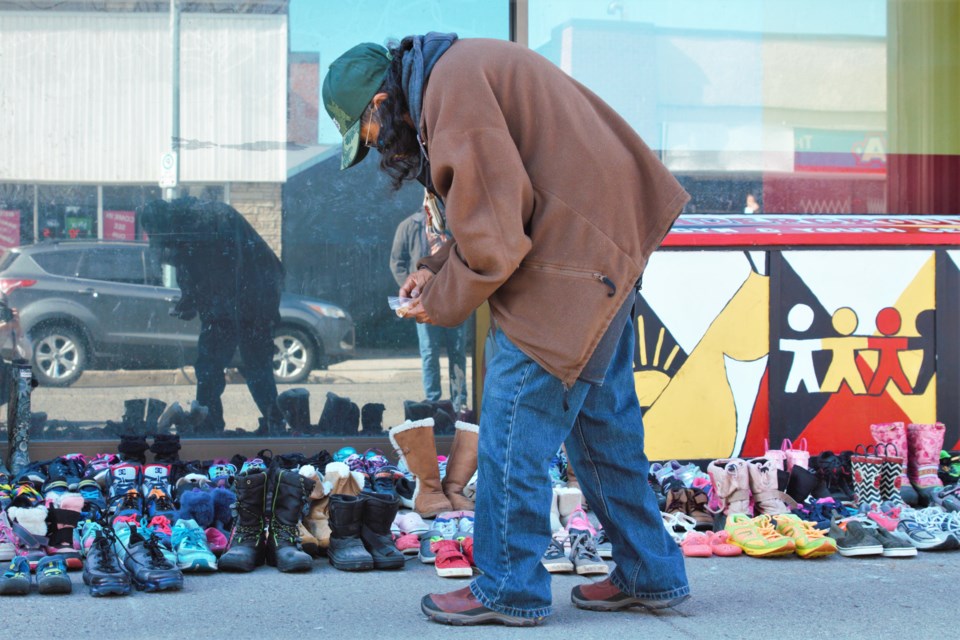THUNDER BAY – Dozens gathered to pay their respects at a makeshift ceremony in Thunder Bay’s south end Monday, after the discovery last week of hundreds of children in an unmarked grave at a British Columbia residential school.
Attendees gathered 215 pairs of shoes in front of the Underground Gym, symbolizing the number of children the Tk'emlúps te Secwépemc say were discovered by ground-penetrating radar.
The B.C. First Nation announced Thursday that the remains had been discovered on the site of the former Kamloops Indian Residential School, which operated between 1890 and 1969. The deaths were previously undocumented, the First Nation said.
Several people impacted by residential schools who attended Monday’s ceremony at the Underground Gym said the discovery was heart-breaking, but it fit with their lived experience of the institutions.
“The tragedy in Kamloops, I believe it’s not the only school that has these mass graves,” wrote residential school survivor Ina Commanda in a letter read by her daughter, Elizabeth Willis.
Commanda attended residential schools in Sioux Lookout and Kenora, she said.
“Lots of children did not return to their parents. Parents trying to find out about their children were told lies from the government and the schools.”
Ma-Nee Chacaby agreed. Nine of her siblings went to residential school, and only three survived, she said.
When her little brother came back from the McIntosh Indian Residential School in the Kenora District, “he didn’t say anything for a long time.”
When he did speak months later, he related his experience of deaths at the school, she said.
“He said there were some kids [who] died, but parents never came to get the kids that were dying,” she said. “There’s graves everywhere, not just in B.C.”
The final report of the Truth and Reconciliation Commission, published in 2015, found that residential schools often did not send the bodies of students who died home, and sometimes did not inform families or even record the names of the children.
It identified 3,200 student deaths across the country, but concluded many deaths likely went unrecorded, due to limited record-keeping or the destruction of records afterwards.
In 2009, the federal government declined a request for additional funding from the TRC to more fully investigate the question of student deaths at residential schools.
Diane Moir-Ogima, who helped organize the ceremony Monday, said she felt compelled to honour not just the children, but their families.
“Some went to their graves not knowing where their loved ones were,” she said. “I’m sure there’s a lot more out there that are buried.”
“I can identify [with] a lot of stuff that happened. We’re all survivors – they’re survivors of the residential school, I’m a survivor of the ‘60s scoop. My heart went right out to the 215 kids – it just broke my heart.”
The history is difficult to talk about, survivors said, but must be learned and confronted by Canadians.
“I don’t have any good memories of those years at all,” Willis read from her mother’s letter. “Even if I got an education in reading, writing, and all of the other subjects, I learned about something else that was so dark, I put it in the corners of my heart and soul. I never talked about it for years and years, until the inquiry started.”
“Then I remembered everything: my grandmother tried to hide me when the Indian Affairs agent came with the Mounties, then [being taken] away from my family, not understanding about all of the abuse that was forced on us… If it wasn’t for the older students who took it upon themselves to comfort the younger ones, how many of us would have survived?”
Holding the ceremony was one way to try to ensure that legacy isn’t swept under the rug, Moir-Ogima said.
“They have to be noticed, they can’t be forgotten,” she said of the 215 children. “I hope they’re never forgotten – I hope they’re not going to be thrown under the bus after this is all said and done, this week, next week.”
Commanda similarly expressed skepticism about symbolic gestures like lowering flags and issuing apologies from institutions she believes are still perpetuating similar harms against Indigenous people today.
“They will be talking about truth and reconciliation and offering an apology,” she wrote. “They can apologize until they’re blue in the face – it doesn’t change anything. There is still a lot of racism out there, there are still a lot of deaths of First Nations people.
“We’re not saying this to make people feel sad, we’re saying this to bring awareness to other people to what we [have gone through].”
The pain lingers, but for Chacaby, Monday’s ceremony showed that the Indigenous cultures residential schools were intended to stamp out had proven far more powerful.
“It’s all about colonization,” she said. “They wanted us to speak English, they wanted us to get rid of our colour. We couldn’t [do that] – we are who we are. We are Anishinaabe, proud and strong people.”
For former students and others impacted, a National Indian Residential School Crisis Line is available 24 hours a day at 1-866-925-4419.
